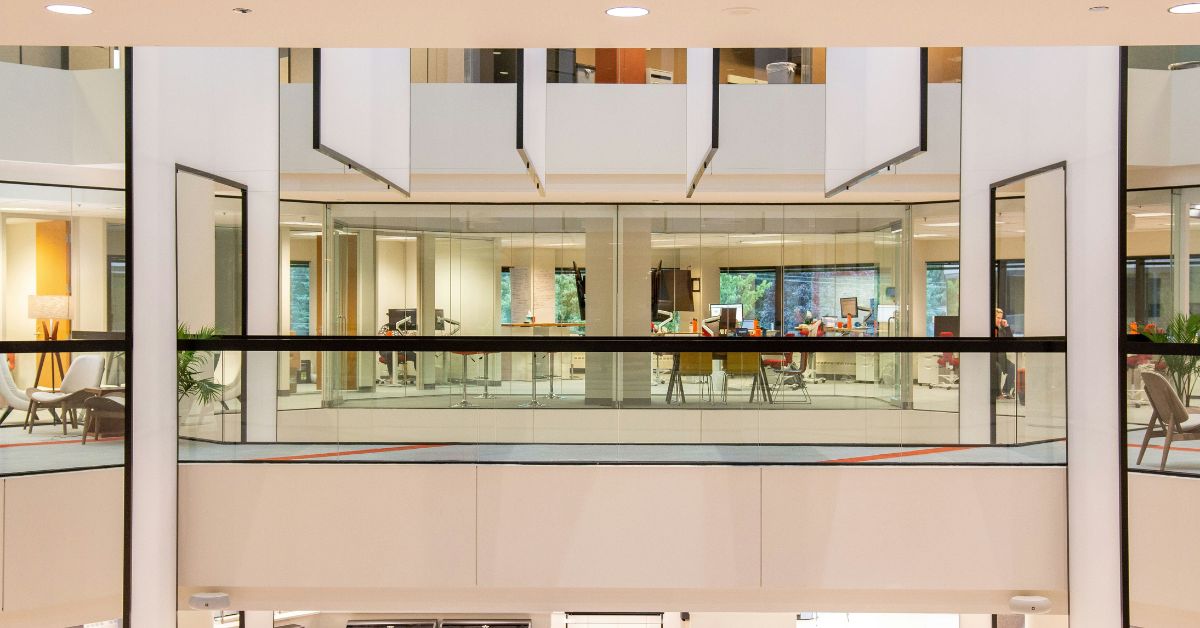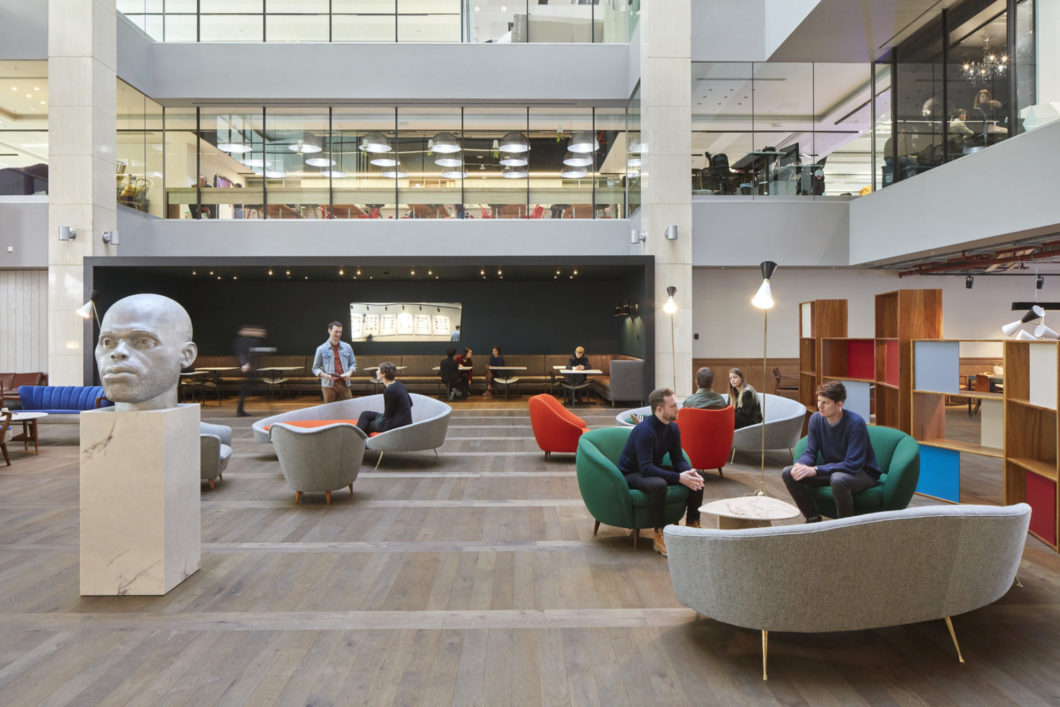An office space promoting wellbeing, productivity and company culture through thoughtful design, valuing employees, and facilitating work-life balance makes a great workplace.
By Making Moves London
May 22, 2024
The working environment has become an important factor in wellbeing and it’s something that a lot of companies need to consider more carefully. Whether it’s to boost productivity or to encourage a more social working environment, it may be worth thinking about changing the layout of your office space. Everyone wants to work in a healthy, happy workplace – so it’s essential for employers to consider what makes a great place to work.
So, what makes a good office space? There are a whole range of things to think about– from lighting, to desk positioning, through to flexible working strategies. At Making Moves, we consider ourselves experts in office design, so we’ve put together a handy list of all the key things that we believe are important in creating the best office layout.
It’s important to create an office space that your employees actually want to work in. If it’s dark, dingy and cluttered, the chances are you aren’t creating a positive working environment. With the increase of hybrid working, good workplaces should be an exciting alternative to working from home, with home comforts like soft furnishings and hanging artwork.
Access to natural lighting is important for both mental and physical health, so consider making the most of it when choosing where desks and workspaces will go. Plants are also a good option for your office space; they add a point of interest, as well as having health benefits.
One of the things that makes a good office space is a sense of individuality. Big open-plan offices can seem sterile and unfriendly so you could consider breaking up teams with open bookcases; this will also improve the acoustics of the office. Another good tip is to keep your office space on-brand. This helps visitors get a sense of who you are as a company, but it also keeps your team focused on your goals and sense of identity.
Having an office that stands out from the crowd can also help leaving a lasting impression on clients as well as attract new talent to your business – take the well-known slides found in many of Google’s offices for example.
We believe that the best office layouts are those that carefully consider placement. You know the needs of your company best so use that knowledge when you are organising your teams. When designing an office space, our relocation experts always begin with an office usage audit – to see how employees actually use the space you have. Designing an office with your team in mind can help you maximise efficiency within the workplace.
For example, particular teams will need to collaborate and discuss their work more than others, so make sure you place them close to one another to maximise ease and minimise disruption. Similarly, teams who need to focus, or those who are working on confidential items, are best placed away from breakout spaces and communal areas. When space is limited, it’s important to make the most of the room that you do have.
In larger offices, fostering a sense of community can be challenging but is essential to company culture. If you carefully plan the flow around your office, it gives people the chance to move around and get to know one another.
It’s also important to have a breakout space that people actually want to use; it should be big enough to encourage social interaction. With the rise of hybrid working, socialising is now one of the main reasons that makes people want to come into the office – so creating a space that facilitates this is key to creating a great place to work.
When you consider what makes a good office space, you might instantly think about the aesthetics or the facilities. However, the most important factor is the happiness of your employees – who will be using this space every day.
Having a choice in where and how you work is the most essential element of wellbeing in working life. Getting your team involved in the design of your office space can help them feel valued as an employee, and give them a sense of pride in their workplace. A group discussion or a simple survey can be a great way to get everybody’s input.
Following covid and the rise of hybrid working, offices that are designed to allow people to move around and have options for different types of work make the best workplace environments. Flexible office spaces are well-suited to those who prefer agile working, giving people the opportunity to work without a set base.
Hot desking, for example, can help maximise space whilst also encouraging communication and collaboration across teams. Similarly, zoom booths have risen in popularity due to the increase in virtual meetings. Having a space that encourages a positive work culture and a sense of community is especially important for businesses that employ freelance staff or temporary contracts.
While sociable offices are great, they can become overwhelming for people who need a quieter working environment. This can be especially important for neurodivergent workers, who have different ways of thinking, learning and perceiving the world.
While hot desking or agile working can be a good option for some, it can be a source of anxiety for those who prefer stability so it’s important to get feedback from your employees to create the best office layout for them. Making sure that you have somewhere quiet employees can go, or a flexible working policy that allows them to work from home, will help make your workplace more inclusive.
With the rise in popularity of remote working, people are relying on the office space as a creative and community hub, rather than just a place for work. Employees need to feel supported in the office environment, as well as having agency over how they work. We believe listening to your employees will help you create the best office layout. It will also inspire productivity, encourage socialisation and improve wellbeing.
This can be achieved through technology – such as checking in with remote workers through video calls – as well as the use of collaborative workspaces like smaller meeting rooms and break out spaces. Giving employees a say in the office design can help maintain a sense of community and shared vision.
If you think about it, the office really is a cornerstone of company culture – and should therefore reflect the values of your company. Consider what your office space communicates to those that walk through the door – does it get across the type of company that you are trying to build?
Nobody wants to spend time in a space that makes them feel down or uninspired. When it comes to creating an office space that promotes a company culture, it’s less about the ‘things’ you have within it, but more about how it makes your employees feel. Nobody wants to spend time in a space that makes them feel down or uninspired. Instead an office should feel like a safe space, with room for learning and collaborating with one another.
Good office spaces should also reflect the corporate and social responsibilities of the workplace. If your company preaches sustainability, your office space should echo this. Being considerate of the materials, lighting and energy efficiency of your office space can all contribute to becoming a more sustainable workplace.
Similarly a good office space should facilitate your CSR efforts – such as having spaces for any charitable events that you hold, or spaces that foster important discussions. Having an office that places the values of the business to the forefront, will act as a permanent reminder to employees to do their bit.
Office spaces that place importance on after-work activities, as well as just those that occur within work hours, are often regarded as making great places to work. Having places for colleagues to socialise during their lunch breaks, and after work, can make work much more enjoyable for your staff and promote a healthy work-life balance.
Dart boards and pool tables can be a fun way to help staff switch off after work – similarly some workplaces bring out a drinks trolley or open bar on a Friday. Regular team bonding outside of work hours can help employees communicate and collaborate with each other more effectively during work. Work hard, play hard.
Good workplaces value the comfort of their employees, and do so by investing in ergonomic furniture. We all know how uncomfortable it can be to sit on a chair all day that hasn’t been designed for long periods of work. Instead ergonomic office chairs are specially designed to encourage workers to sit upright, supporting their back, neck, shoulders and hips.
Similarly standing desks, or adjustable laptop stands, can help workers avoid the dreaded ‘tech neck’ – caused by poor posture when using computers and phones. Ergonomic keyboards and mice can even help prevent muscle strain, and adjusting the monitor and display of screens can reduce straining our eyes. All of these considerations can help make your employees as comfortable as possible, and therefore less susceptible to distractions.
Having some good work-perks can also help solidify your office as a great place to work – whether this is always having top quality coffee or putting on a good breakfast spread for your staff. Investing in top-tier amenities can help make your staff feel more valued at work – which can help indirectly boost their motivation and productivity.
Many workplaces offer benefits packages to their staff, including perks like access to gyms, mental health services and cycle-to-work schemes. These can improve the mental and physical health of your team, and in turn, decrease spend on sick pay. Offices that have a range of amenities in their local area – like good nightlife, and green spaces – can also boost staff morale, and make the office a better workplace environment for all that work there.
In this day and age, all office spaces should be fully accessible – and this means more than simply having a ramp or lift for those in wheelchairs. Whilst this is often easier for modern, purpose built workspaces, it is essential that all workplaces provide equal opportunities for staff – therefore it’s essential to design your office space with disabilities in mind. Having an accessible office space is a win for everyone.
Ensuring that there is plenty of space between desks, even flooring and accessible toilets are just some of the ways that can help make your office more accessible for those with mobility issues. Whilst those with hearing difficulties may benefit from smaller, enclosed meeting spaces – with circular tables that allow all employees to maintain eye and lip contact throughout meetings. Quiet rooms, calming colours and comfortable seating can also cater towards neurodivergent employees.
A healthy workplace is a happy workplace – therefore it’s important you design your office space with wellness in mind. Maximising natural light, fresh air and plenty of plants can all help create a calming office for your employees, helping them focus on the tasks at hand.
Offering fruit, healthy snacks and water can all help keep energy levels up, and maintaining a quiet, calm environment for employees to work will help improve their concentration and increase productivity. Noise can travel through open plan offices, so having meeting rooms or zoom booths will help keep these conversations private.
Another factor that should be considered when designing a great office space, is how the space itself facilitates a healthy work life balance. Overworking employees will not only lead to a decline in morale, but also productivity – increasing the amount of mistakes that get made.
Having an office space that is easily accessible – in that the location is easy to get to, the opening hours suit hybrid workers and the tech allows people to work from home when they choose to do so – is key to facilitating a healthy work life balance. Being close to green spaces, or having areas for staff to socialise away from their desks during lunch hours, will help staff switch off from work and feel more refreshed when they return.
While it might sound counterproductive, good office spaces encourage workers to move around regularly. Sitting at a desk for long periods of time can make us feel sluggish and lethargic, and sedentary lifestyles have even been linked to diabetes, heart disease and obesity. Encouraging employees to break up periods of sitting with light exercise will help keep them alert and focused on their work.
Office spaces can promote movement by providing different spaces that employees can work in – such as meeting rooms, break out areas, as well as desks – and encouraging them to regularly switch between these. Some offices even set competitions on who can do the most steps in a day, or rewarding those who use the stairs or walk to walk to help encourage activity. Standing desks can also be a great way to reduce the total amount of hours staff spend sitting.
Having a space that is easy to keep clean is also a factor that can make somewhere a great place to work. Your staff likely have enough to do than worry about mess, so designing a low maintenance office space will help them keep their energy for their work. Cluttered spaces can negatively affect our mental health – increasing levels of cortisol, the stress hormone, and making us feel anxious and overwhelmed. A messy room is a messy mind after all.
The best workplace environment is one that has plenty of storage – meaning everything has a place. While allowing employees to personalise their desks can boost morale, make sure they don’t become too busy. Having plenty of bins around the office will ensure people do not leave rubbish lying around. Having pride in where you work often motivates employees to want to work harder – so it’s a win win.
When global gaming company ComeOn needed a new office, they wanted a space that captured their company culture of “fun at work” while remaining cost-efficient. Making Moves stepped in to deliver a tailored solution, recommending up-and-coming areas of London that aligned with their goals.

By securing a vibrant, modern space at a comparable rental rate to their previous office, we not only embraced their creative company ethos but also negotiated significant savings of £1.3 million. This new workspace allowed ComeOn to continue fostering innovation and collaboration in an environment that truly reflects their brand.
Want to learn more? Explore the full ComeOn case study here or visit our case study archive for more success stories.
So now that you’ve reached the end of our list, you should be feeling a lot more knowledgeable on what makes a great place to work.
At its core, creating a great place to work is not just about the physical environment, but about creating a space that fosters a positive culture, and promotes the wellbeing of its staff. While offices are of course a place to work, the best workplace environments are ones where employees feel valued, comfortable and inspired.
Remember, offices aren’t one size fits all, so what’s right for another business might not be right for yours. Here at Making Moves, we can help provide tailored relocation consultancy, or even manage your office fit out, so if you’re considering moving office, or you need some guidance on creating the best office environment, get in touch today.

🚚 Source, negotiate and manage entire office moves.
🏢 Dispose, sublet or redesign your office.
🖊️ Professional, independent support.